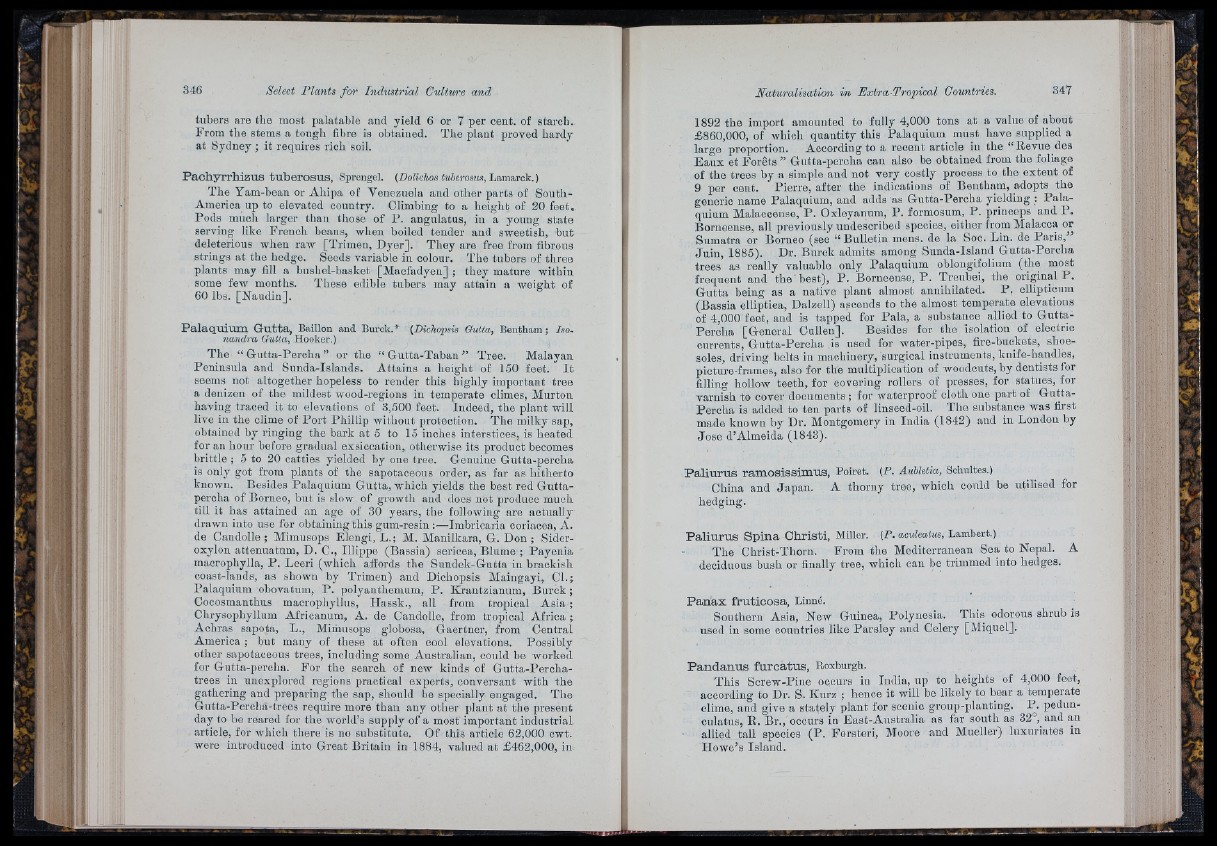
fíiíí-; ;
Select Plants fo r Industrial Culture and
tubers are the most palatable and yield 6 or 7 per cent, of starch.
From the stems a tough fibre is obtained. The plant proved hardy
at Sydney ; it requires rich soil.
Pachyrrhizus tuberosus, Sprengel. (PoiicAos tafterosas, Lamarck.)
The Yam-bean or Ahipa of Venezuela and other parts of South-
America up to elevated country. Climbing to a height of 20 feet..
Pods much larger than those of P. angulatus, in a young state
serving like French beans, when boiled tender aud sweetish, but
deleterious when raw [Trimen, Dyer]. They are free from fibrous
strings at the hedge. Seeds variable in colour. The tubers of three
plants may fill a bnshel-basket [Macfadyen] ; they mature within
some few months. These edible tubers may attain a weight of
60 lbs. [Naudin].
Palaquium Gutta, Bâillon and Burok.*
nandra Gutta, Hooker.)
(Dichopsis Gutta, Bentham ; Iso.
The “ Gutta-Percha ” or the “ Gutta-Taban ” Tree. Malayan
Peninsula and Sunda-Islands. Attains a height of 150 feet. I t
seems not altogether hopeless to render this highly important tree
a denizen of the mildest wood-regions in temperate climes, Murtón
having traced it to elevations of 3,500 feet. Indeed, the plant will
live in the clime of Po rt Phillip without protection. The milky sap,
obtained by ringing the bark a t 5 to 15 inches interstices, is heated
for an hour before gradual exsiccation, otherwise its product becomes
brittle ; 5 to 20 catties yielded by one tree. Genuine Gutta-percha
is only got from plants of the sapotaceous order, as far as hitherto
known. Besides Palaquium Gutta, which yields the best red Guttapercha
of Borneo, but is slow of growth and does not produce much
till it has attained an age of 30 years, the following are actually
drawn into nse for obtaining this gum-resin ;■—Imbricaría coriacea, A.
de Candolle ; Mimusops Elengi, L .; M. Manilkara, G. Don ; Sideroxylon
attenuatnm, D. C., Illippe (Bassia) sericea, Blume ; Payenia
macrophylla, P . Leeri (which affords tlie Sundek-Gutta in brackish
coast-lands, as shown by Trimen) and Dichopsis Maingayi, Cl.;
Palaquium obovatum, P . polyanthemum, P . Krantzianum, Burok ;
Cocosmanthus macrophyllus, Hassk., all from tropical Asia ;
Chrysophyllum Afrioanum, A. de Candolle, from tropical Africa ;
Achras sapota, L., Mimusops globosa, Gaertner, from Central
America ; but many of these at often cool elevations. Possibly
other sapotaceous trees, including some Australian, could be worked
for Gutta-percha. For the search of new kinds of Gutta-Percha-
trees in unexplored regions practical experts, conversant with the
gathering and preparing the sap, should be specially engaged. Tlie
Gutta-Percha-trees require more than any other plant a t the present
day to be reared for the world’s supply of a most important industrial
article, for which there is no substitute. Of this article 62,000 cwt.
were introduced into Great Britain in 1884, valued a t £462,000, in
1892 the import amounted to fully 4,000 tons at a value of about
£860,000, of which quantity this Palaquium must have supplied a
large proportion. According to a recent article in the “ Revue des
E au x et Forêts ” Gutta-percha can also be obtained from the foliage
of the trees by a simple and not very costly process to the extent of
9 per cent. Pierre, after the indications of Bentham, adopts the
generic name Palaquium, and adds as Gutta-Percha yielding : P a la quium
Malaocense, P. Oxleyannm, P . formosum, P . princeps and P .
Borneense, all previously nndesoribed species, either from Malacca or
Sumatra or Borneo (see “ Bulletin mens, de la Soc. Lin. de Paris,”
Ju in , 1885). Dr. Burck admits among Sunda-Island Gutta-Percha
trees as really valuable only Palaquium oblongifolium (the most
frequent and the best), P . Borneense, P . Treubei, the original P .
G u tta being as a native plant almost annihilated. P . ellipticum
(Bassia elliptiea, Dalzell) ascends to the almost temperate elevations
of 4,000 feet, and is tapped for Pala, a substance allied to Gutta-
Percha [General Cullen]. Besides for the isolation of electric
currents, Gutta-Percha is nsed for water-pipes, fire-buckets, shoe-
soles, driving belts iu machinery, surgical instruments, knife-handles,
picture-frames, also for the multiplication of woodcuts, by dentists for
filling hollow teeth, for covering rollers of presses, for statues, for
varnish to cover documents ; for waterproof cloth one part of Gutia-
Peroha is added to ten parts of linseed-oil. The substance was first
made known by Dr. Montgomery in India (1842) and in London by
Jose d’Almeida (1843).
Paliurus ramosissimus, Poiret. (P. AuUetia, Schultes.)
China and Japan. A thorny tree, which could be utilised for
hedging.
Paliurus Spina Christi, Miller. (P. aadeatus, Lambert.)
The Christ-Thorn. From the Mediterranean Sea to Nepal. A
deciduous bush or finally tree, which can be trimmed into hedges.
Panax frutioosa, Linné.
Southern Asia, New Guinea, Polynesia. This odorous shrub is
used in some countries like Parsley and Celery [Miquel].
Pandanns furcatus, Roxburgh.
This Screw-Pine occurs in India, up to heights of 4,000 feet,
according to Dr. S. Kurz ; hence it will be likely to bear a temperate
clime, and give a stately plant for scenic group-planting. P . pedun-
culatus, R. Br., occurs in East-Australia as far south as 32°, and an
• allied tall species (P. Forsteri, Moore and Mueller) luxuriates in
Howe’s Island.